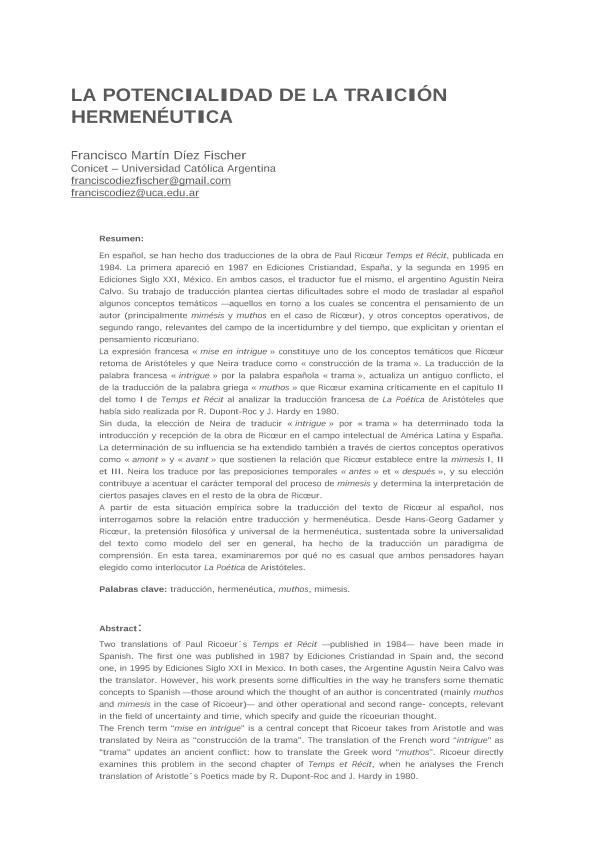Artículo
En español, se han hecho dos traducciones de la obra de Paul Ricœur Temps et Récit, publicada en 1984. La primera apareció en 1987 en Ediciones Cristiandad, España, y la segunda en 1995 en Ediciones Siglo XXI, México. En ambos casos, el traductor fue el mismo, el argentino Agustín Neira Calvo. Su trabajo de traducción plantea ciertas dificultades sobre el modo de trasladar al español algunos conceptos temáticos —aquellos en torno a los cuales se concentra el pensamiento de un autor (principalmente mimésis y muthos en el caso de Ricœur), y otros conceptos operativos, de segundo rango, relevantes del campo de la incertidumbre y del tiempo, que explicitan y orientan el pensamiento ricœuriano. La expresión francesa « mise en intrigue » constituye uno de los conceptos temáticos que Ricœur retoma de Aristóteles y que Neira traduce como « construcción de la trama ». La traducción de la palabra francesa « intrigue » por la palabra española « trama », actualiza un antiguo conflicto, el de la traducción de la palabra griega « muthos » que Ricœur examina críticamente en el capítulo II del tomo I de Temps et Récit al analizar la traducción francesa de La Poética de Aristóteles que había sido realizada por R. Dupont-Roc y J. Hardy en 1980. Sin duda, la elección de Neira de traducir « intrigue » por « trama » ha determinado toda la introducción y recepción de la obra de Ricœur en el campo intelectual de América Latina y España. La determinación de su influencia se ha extendido también a través de ciertos conceptos operativos como « amont » y « avant » que sostienen la relación que Ricœur establece entre la mimesis I, II et III. Neira los traduce por las preposiciones temporales « antes » et « después », y su elección contribuye a acentuar el carácter temporal del proceso de mimesis y determina la interpretación de ciertos pasajes claves en el resto de la obra de Ricœur. A partir de esta situación empírica sobre la traducción del texto de Ricœur al español, nos interrogamos sobre la relación entre traducción y hermenéutica. Desde Hans-Georg Gadamer y Ricœur, la pretensión filosófica y universal de la hermenéutica, sustentada sobre la universalidad del texto como modelo del ser en general, ha hecho de la traducción un paradigma de comprensión. En esta tarea, examinaremos por qué no es casual que ambos pensadores hayan elegido como interlocutor La Poética de Aristóteles. Two translations of Paul Ricoeur's Temps et Récit —published in 1984— have been made in Spanish. The first one was published in 1987 by Ediciones Cristiandad in Spain and, the second one, in 1995 by Ediciones Siglo XXI in Mexico. In both cases, the Argentine Agustín Neira Calvo was the translator. However, his work presents some difficulties in the way he transfers some thematic concepts to Spanish —those around which the thought of an author is concentrated (mainly muthos and mimesis in the case of Ricoeur)— and other operational and second range- concepts, relevant in the field of uncertainty and time, which specify and guide the ricoeurian thought. The French term “mise en intrigue” is a central concept that Ricoeur takes from Aristotle and was translated by Neira as “construcción de la trama”. The translation of the French word “intrigue” as “trama” updates an ancient conflict: how to translate the Greek word “muthos”. Ricoeur directly examines this problem in the second chapter of Temps et Récit, when he analyses the French translation of Aristotle´s Poetics made by R. Dupont-Roc and J. Hardy in 1980. There is no doubt that the translation of “intrigue” as “trama” has influenced the reception and the introduction of Ricoeur´s work in Latin America and Spain. The determination of its influence has spread through certain concepts as “amont” and “avant” that are fundamental to the relationship Ricoeur establishes among mimesis I, II and III. Neira translates them with the temporal prepositions “antes” and “después” and his choice helps emphasize the temporal nature of the mimesis process and it determines the interpretation of certain key passages in the rest of Ricoeur´s work. From this empirical situation in the translation of Ricoeur´s text to Spanish, we will analyse the relationship between translation and hermeneutics. Since Hans-Georg Gadamer and Ricoeur, the philosophical and universal aspiration of hermeneutics —based on the universality of the text as a model of the being in general— has transformed translation into a paradigm for understanding. In this sense, we will examine why it is not a coincidence that both thinkers chose Aristotle's Poetics as their interlocutor.
La potencialidad de la traición hermenéutica
Fecha de publicación:
11/2013
Editorial:
Universidad Autónoma de Barcelona. Grup Étienne Dolet
Revista:
Doletiana, revista de traducció literatura i arts
ISSN:
1988-3366
Idioma:
Español
Tipo de recurso:
Artículo publicado
Clasificación temática:
Resumen
Palabras clave:
Traducción
,
Ricoeur
,
Hermeneutica
,
Traición
Archivos asociados
Licencia
Identificadores
Colecciones
Articulos(SEDE CENTRAL)
Articulos de SEDE CENTRAL
Articulos de SEDE CENTRAL
Citación
Díez, Francisco; La potencialidad de la traición hermenéutica; Universidad Autónoma de Barcelona. Grup Étienne Dolet; Doletiana, revista de traducció literatura i arts; 4; 11-2013; 1-10
Compartir




